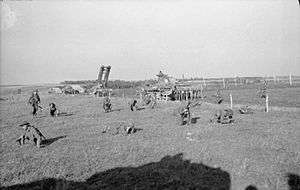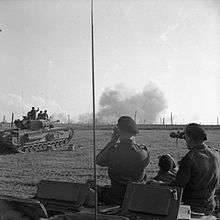Operation Astonia
| Operation Astonia | |||||||
|---|---|---|---|---|---|---|---|
| Part of Western Front, World War II | |||||||
 Churchill bridgelayers, Sherman flail tanks and infantry following the assault on Le Havre, 13 September 1944 | |||||||
| |||||||
| Belligerents | |||||||
|
|
| ||||||
| Commanders and leaders | |||||||
|
|
| ||||||
| Strength | |||||||
| 45,000 troops including specialised AVRE vehicles[1] | at least 12,000 | ||||||
| Casualties and losses | |||||||
| less than 500, including 35 armoured vehicles[2] |
600 killed 11,300 captured[2] | ||||||
Operation Astonia was the codename for the Allied effort to capture the German-held Channel port of Le Havre, France, during World War II. Fought from 10–12 September 1944, its objective was to secure the fortress city's harbor facilities intact to aid the Allied supply system on the Continental Europe. However, due to extensive damage the port was not ready for use until mid October 1944.
The attack was carried out by the British 49th (West Riding) Infantry Division and the 51st (Highland) Infantry Division, aided by elements of Canadian forces and action from naval and aviation units. After a substantial softening up Royal Navy bombardment ships and heavy raids by the Royal Air Force the city fell within three days of the first infantry assault.
Background
On D-Day, 6 June 1944, Allied troops landed at beaches in the Normandy area of the north coast of France in Operation Overlord to begin the liberation of France. Plans for the invasion required four[2] ports on the French coast to be captured to allow Allied forces to be reinforced and supplied: Le Havre, Dieppe, Calais, and Dunkirk.
After crossing the river Seine British I Corps and II Canadian Corps, under First Canadian Army and forming the left flank of Montgomery's 21st Army Group, were tasked to fan out and capture respectively the ports of Le Havre and Dieppe and then clear the coastal belt as far as Bruges.[3] Dieppe was evacuated by the Germans[3] and occupied by the 2nd Canadian Division on 1 September 1944.[2]
Considered one of the strongest fortifications in the Atlantic Wall, Le Havre was also aided by strong natural defences that included bodies of water preventing access from the south, east and west.[2] The north side of the port was heavily fortified, with a 6–7-metre (20–23 ft) deep and 3-metre (9.8 ft) wide anti-tank ditch stretching across the entire approach, pillboxes fitted with anti-tank and machine guns and 1,500 mines.[2] Intelligence before the attack estimated there were between 7,300 and 8,700 soldiers in the city, of which 4,000 were artillery troops, 1,300 were naval personnel and the rest a mixture of low-quality infantry and a battalion from the recently constituted 36th Grenadier Regiment[2] formed out of the survivors of the 36th Infantry Division after its destruction at Bobruysk in Belarus in June 1944.
Preparations
Plans called for a massive naval and air bombardment to soften up the fortifications. Two Royal Navy vessels, the battleship HMS Warspite and the monitor HMS Erebus, bombarded the port with more than 4,000 long tons (4,100 t) of shells over several days.[4] In addition, aircraft of the Royal Air Force dropped 8,200 long tons (8,300 t) of high explosive bombs on the city between September 5 and September 7.[2]
Assault

The attack plan was to penetrate the German defences to allow further forces to attack, then further these gains and capture the city. An assault of two divisions began at 1745 hours on 10 September, with both naval bombardment vessels engaging the coastal batteries defending the port and RAF bombers dropping an additional 5,000 long tons (5,100 t) of bombs ninety minutes prior to commencing.[5]
With the assistance of specialist units from the 79th Armoured Division and the 1st Canadian Armoured Carrier Regiment, such as Kangaroos and Sherman Crab vehicles, the first part of the assault proceeded swiftly, with gaps cleared through the minefield and anti-tank ditches breached.[2] The 49th (West Riding) Infantry Division penetrated the north-eastern section of the Le Havre perimeter first, followed by the 51st (Highland) Infantry Division[5] attacking on their right from the north.[6] The assault was costly for the specialised armour, however, with the 79th Armoured Division losing 34 Crab anti-mine flail tanks, two command tanks and 6 AVRE vehicles.[6]
The attack on German defences continued into the second day with support from various aircraft and armoured vehicles; facing the threat of Churchill Crocodile flame throwing tanks, the last outer defence strongpoints finally surrendered at 1400 hours. On the third day of the assault the town centre was finally cleared by elements of both divisions, forcing the German garrison commander's official surrender at 1145, 12 September; 12,000 German troops were captured and interned as prisoners of war.[2][5]
Aftermath
While there had been few military casualties during Le Havre's successful capture, from a tactical standpoint the action was a partial failure. Damage to infrastructure was severe: the artillery and air assaults had destroyed 350 vessels, 18 kilometres (11 mi) of docks, and 15,000 buildings, significantly reducing the usefulness of the city as a supply port.[2] Civilian loss was also high, but had been avoidable.
British officer William Douglas-Home was imprisoned for his refusal to participate in the operation after his superiors spurned the German garrison commander Hermann-Eberhard Wildermuth's request to evacuate civilians before the assault. Faced with the Allied policy of unconditional surrender, Colonel Wildermuth had been ordered by Hitler to defend Fortress Le Havre to the last man. Recognizing an indiscriminate pre-assault aerial bombardment would kill many innocent Frenchmen he appealed to British humanity, and reiterated his offer even after the bombing campaign started. Loss of French life was extensive, with some 2,000 dead to 19 Germans lost during the air campaign alone.
References
- ↑ "History of Normandy - The Fortress of Le Havre (76)". Retrieved 2008-12-22.
- 1 2 3 4 5 6 7 8 9 10 11 Hyrman, Jan. "Clearing the Channel Ports: Operation Astonia - The Capture of Le Havre". Retrieved 2008-12-22.
- 1 2 Ellis 2004, p. 6.
- ↑ Copp, Terry (2006). Cinderella Army. University of Toronto Press. p. 59. ISBN 9780802039255. Retrieved 2008-12-22.
- 1 2 3 Montgomery, p. 134
- 1 2 Ellis 2004, p. 14.
Bibliography
- Montgomery, Field Marshal Bernard (1965) [1948]. Normandy to the Baltic. Grey Arrow.
- Copp, Terry (2006). The Canadians in Northwest Europe, 1944-1945. University of Toronto Press. ISBN 978-0-8020-3925-5.
- Delaforce, Patrick (2000) [1998]. Churchill's Secret Weapons: The Story of Hobart's Funnies. Robert Hale Ltd. ISBN 0-7090-6722-4.
- Delafoce, Patrick (1999) [1995]. The Polar Bears: Monty's Left Flank: From Normandy to the Relief of Holland with the 49th Division. Chancellor Press. ISBN 0-7537-0265-7.
- Ellis, Major L.F. (2004) [1st. pub. HMSO:1968]. Butler, Sir James, ed. Victory in the West, Volume II: The Defeat of Germany. History of the Second World War, United Kingdom Military Series. Uckfield, UK: Naval & Military Press. ISBN 1-84574-059-9.